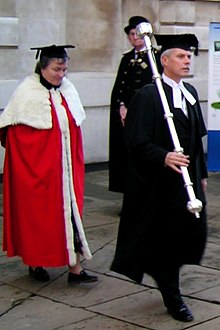Postgraduate education: Difference between revisions
No edit summary |
Sushi rider (talk | contribs) No edit summary |
||
| Line 49: | Line 49: | ||
*J.A. Burns. [http://www.newadvent.org/cathen/01759a.htm "Master of Arts"] (''The Catholic Encyclopedia'', 1909) |
*J.A. Burns. [http://www.newadvent.org/cathen/01759a.htm "Master of Arts"] (''The Catholic Encyclopedia'', 1909) |
||
*E.A. Pace. [http://www.newadvent.org/cathen/05072b.htm "Doctor"] (''The Catholic Encyclopedia'', 1909) |
*E.A. Pace. [http://www.newadvent.org/cathen/05072b.htm "Doctor"] (''The Catholic Encyclopedia'', 1909) |
||
* [http://www.hotcourses.com/postgraduate_courses/ UK Postgraduate Courses and University and College Profiles] (from Hotcourses) |
|||
Revision as of 10:28, 2 August 2006

Postgraduate education (or graduate education) involves studying for degrees or other qualifications for which a first or Bachelor's degree is required, and is normally considered to be part of tertiary or higher education. In North America this level is generally referred to as Graduate school.
The organisation and structure of postgraduate education is very different in different countries, and also in different institutions within countries. This article sets out the basic types of course and of teaching and examination methods, with some explanation of their history. More detailed treatments of the different types of degree can be found at the relevant specific articles: Master's degree and Doctorate.
Types of postgraduate qualification
There are four main types of qualification studied for at the postgraduate level: academic and vocational degrees, and academic and vocational certificates and diplomas.
Degrees
The term "degree" in this context means the moving from one stage or level to another (from the Latin "de-" + "gradus", through Old French "degre"), and first appeared in the 13th century.
History
Although systems of higher education go back to Ancient Greece, China, and India, the concept of postgraduate education depends upon the system of awarding degrees at different levels of study, and can be traced to the workings of the European mediæval universities.
University studies took six years for a Bachelor degree and up to twelve additional years for a master's degree or doctorate. The first six years taught the faculty of the arts, which was the study of the seven liberal arts: arithmetic, geometry, astronomy, music theory, grammar, logic, and rhetoric. The main emphasis was on logic. Once a Bachelor of Arts had been obtained, the student could choose one of three faculties – law, medicine, or theology – in which to pursue master's or doctor's degrees. Theology was the most prestigious area of study, and considered to be the most difficult.
The degrees of master (magister) and doctor were for some time equivalent, "the former being more in favour at Paris and the universities modelled after it, and the latter at Bologna and its derivative universities. At Oxford and Cambridge a distinction came to be drawn between the Faculties of Law, Medicine, and Theology and the Faculty of Arts in this respect, the title of Doctor being used for the former, and that of Master for the latter."[1] Because theology was thought to be the highest of the subjects, the doctorate came to be thought of as higher than the master's.[2]
The main significance of the higher, postgraduate degrees was that they licensed the holder to teach ("doctor" comes from the Latin "docere", meaning "teach"; "magister" is Latin for "master", and is also the root of "magistrate").
Modern situation
In most English-speaking countries, the hierarchy of degrees is as follows:
- Associate's degree
- Usually two years; often an intermediate degree before finishing Bachelor's. Many universities do not offer the Associate's degree.
- Bachelor's degrees (undergraduate degrees; first degrees).
- Usually three or four years; in a few cases, a degree called "bachelor" is in fact a postgraduate degree — see, for example, Bachelor of Civil Law, Bachelor of Philosophy.
- Master's degrees
- These are sometimes placed in a further hierarchy, starting with degrees such as the Master of Arts and Master of Science, then Master of Philosophy, and finally Master of Letters.
- Doctorates
- These are often further divided into research and professional doctorates.
In the UK and countries whose education systems were founded on the British model, such as the U.S., the master's degree was for a long time the only postgraduate degree normally awarded, while in most European countries apart from the UK, the master's degree almost disappeared. In the second half of the 19th century, however, U.S. universities began to follow the European model by awarding doctorates, and this practice spread to the UK. Conversely, many European universities now offer master's degrees parallelling their regular system, so as to offer their students better chances to compete in an international market dominated by the American model.[citation needed]
Honorary degrees
Most universities award honorary degrees, usually at the postgraduate level. These are awarded to a wide variety of people, such as artists, musicians, writers, politicians, businesspeople, etc., in recognition of their achievements in their various fields. (Recipients of such degrees do not normally use the associated titles or letters, such as "Dr".)
Non-degree qualifications
Postgraduate education can involve studying for qualifications such as certificates and diplomas — normally held to be lower than degrees. They are sometimes used as steps on the route to a degree, or as part of training for a specific career, or as a qualification in an area of study too narrow to warrant a full degree course.
See also
- List of education articles by country
- Professional Master's degree, including a list
- List of colleges and universities by country
Notes
Sources and external links
- J.A. Burns. "Master of Arts" (The Catholic Encyclopedia, 1909)
- E.A. Pace. "Doctor" (The Catholic Encyclopedia, 1909)
- UK Postgraduate Courses and University and College Profiles (from Hotcourses)
